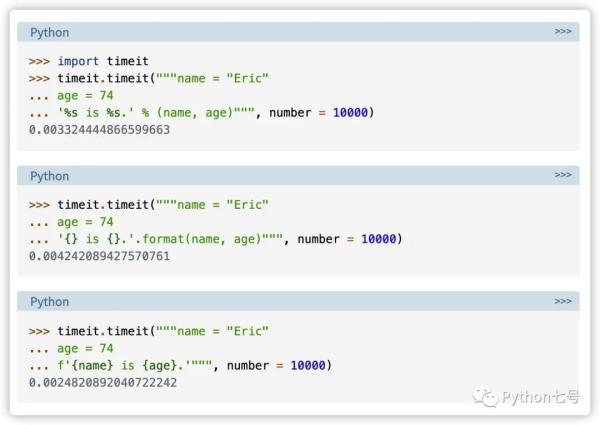Python 中 f-Strings 的作用
更新时间:2021年10月19日 15:49:28 作者:somenzz
这篇文章主要介绍了Python 中 f-Strings 的作用, f-strings 是用来非常方便的格式化输出的,觉得它的使用方法无外乎就是 print(f'value = { value }',其实,f-strings 远超你的预期,今天来梳理一下它还能做那些很酷的事情
学过 Python 的朋友应该都知道 f-strings 是用来非常方便的格式化输出的,觉得它的使用方法无外乎就是 print(f'value = { value }',其实,f-strings 远超你的预期,今天来梳理一下它还能做那些很酷的事情。
1、变量名
str_value = "hello,python coders"
print(f"{ str_value = }")
# str_value = 'hello,python coders'
2、直接改变输出结果
num_value = 123
print(f"{num_value % 2 = }")
# num_value % 2 = 1
3、直接格式化日期
import datetime
today = datetime.date.today()
print(f"{today: %Y%m%d}")
# 20211019
print(f"{today =: %Y%m%d}")
# today = 20211019
4、2/8/16 进制输出真的太简单
>>> a = 42
>>> f"{a:b}" # 2进制
'101010'
>>> f"{a:o}" # 8进制
'52'
>>> f"{a:x}" # 16进制,小写字母
'2a'
>>> f"{a:X}" # 16进制,大写字母
'2A'
>>> f"{a:c}" # ascii 码
'*'
5、格式化浮点数
>>> num_value = 123.456
>>> f'{num_value = :.2f}' #保留 2 位小数
'num_value = 123.46'
>>> nested_format = ".2f" #可以作为变量
>>> print(f'{num_value:{nested_format}}')
123.46
6、字符串对齐
>>> x = 'test'
>>> f'{x:>10}' # 右对齐,左边补空格
' test'
>>> f'{x:*<10}' # 左对齐,右边补*
'test******'
>>> f'{x:=^10}' # 居中,左右补=
'===test==='
>>> x, n = 'test', 10
>>> f'{x:~^{n}}' # 可以传入变量 n
'~~~test~~~'
>>>
7、使用 !s,!r
>>> x = '中'
>>> f"{x!s}" # 相当于 str(x)
'中'
>>> f"{x!r}" # 相当于 repr(x)
"'中'"
8、自定义格式
class MyClass:
def __format__(self, format_spec) -> str:
print(f'MyClass __format__ called with {format_spec=!r}')
return "MyClass()"
print(f'{MyClass():bala bala %%MYFORMAT%%}')
输出如下:
MyClass __format__ called with format_spec='bala bala %%MYFORMAT%%' MyClass()
最后:
Python 的 f-string 非常灵活优雅,同时还是效率最高的字符串拼接方式:

以后关于字符串的格式化,就 f-string 了。
到此这篇关于Python 中 f-Strings 的作用的文章就介绍到这了,更多相关Python f-Strings 内容请搜索脚本之家以前的文章或继续浏览下面的相关文章希望大家以后多多支持脚本之家!
相关文章

Python如何写入Pandas DataFrame到CSV文件
Pandas是一个功能强大的Python数据分析库,常用于处理和分析数据,CSV文件是一种广泛使用的数据交换格式,Pandas通过to_csv方法支持将DataFrame写入CSV文件,此方法允许用户指定分隔符、编码和选择性写入特定列等2024-09-09
python调用pytorch的clip模型时报错原因及解决方法
这篇文章主要介绍了python调用pytorch的clip模型时报错,本文给大家分享问题原因及解决方法,本文结合实例代码给大家介绍的非常详细,对大家的学习或工作具有一定的参考借鉴价值,需要的朋友可以参考下2023-08-08












最新评论